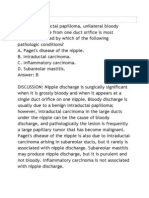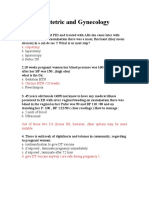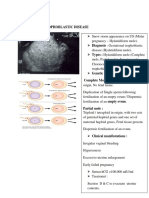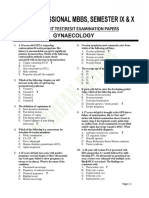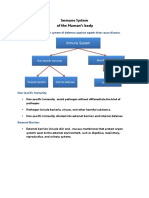Obg MCQS
Obg MCQS
Uploaded by
Shriyansh ChaharCopyright:
Available Formats
Obg MCQS
Obg MCQS
Uploaded by
Shriyansh ChaharOriginal Description:
Original Title
Copyright
Available Formats
Share this document
Did you find this document useful?
Is this content inappropriate?
Copyright:
Available Formats
Obg MCQS
Obg MCQS
Uploaded by
Shriyansh ChaharCopyright:
Available Formats
Sample MCQ questions 1. a. b. c. d. e. Mechanisms of labour in a primigravida.
During the frist stage, the uterine muscle contracts and retracts. The cervix becomes effaced during the latent phase The average length of the first stage is 12 hours Voluntary effort is essential during the second stage to achieve a spontaneous vaginal delivery Braxton Hicks contractions do not occur before 36 weeks.
True: A, B, C False: D,E Voluntary effort is not essential, a paraplegic woman can have a normal delivery. 2. a. b. c. d. e. High-risk features for abnormal glucose tolerance in pregnancy include Maternal weight more than 100 kg at booking Paternal first degree relative with diabetes Foetal microsomia on ultrasound Single episode of glycosuria at 36 weeks Presence of oligohydramnios.
True: A False: B,C, D, E A maternal, not paternal, first-degree relative is a high-risk feature. Foetal macrosomia, not foetal microsomia, and polydraminios are high-risk features for abnormal glucose tolerance. 3. a. b. c. d. e. True: False: All pregnant women are still screened for syphilis The Veneral Disease Research Laboratory (VDRL) slide test is a specific serological test. The VDRL test remains positive for ever once the mother has been infected. Congenital syphilis causes skeletal damage to the neonate. Treatment of syphilis in early pregnancy will not protect the foetus Untreated syphilis may result in prematurity. C, E A,B,D
Every pregnant woman is screened for syphilis, therefore this is a fair question. Wassermann reaction and VDRL are not specific tests and with successful treatment they usually become negative. The reason for continued screening is that early treatment can protect the foetus. 4. a. b. c. d. e. True: False: Binovular twins May occur as a result of fertilsiation of a single ovum Are more common in women under the age of 35 years. Are more common in tall women, Have a separate chorion and amnion Are at increased risk of twin-twin transfusion C, D A, B, E
5. a. b. c. d. e.
Maternal mortality Is defined as the death of a woman associated with pregnancy or with childbirth within 28 days of that event. In England the incidence is 8-6 per 10,000 births. The most common cause is haemorrhage Includes deaths associated with therapeutic termination. The majority of anaesthetic deaths in the last triannual report were associated with epidurals.
True: D False: A, B, C, E Defined as death occurring within 42 days. The missing zero in B makes it false important to read the question carefully. 6. a. b. c. d. e. True: False: Pulmonary embolism Is the commonest cause of maternal death. Three quarters occur following delivery Is more common following an operative delivery Is preceded by signs of a deep venous thrombosis in the majority of cases. A ventiliation-perfusion scan is contraindicated during pregnancy. B, C A, D, E
Pregnancy induced hyptertension/pre eclampsia is the commonest cause of maternal death. 7. a. b. c. d. e. Recognised causes of spontaneous preterm labour include Polyhydramnios Pre-eclampisa Previous ceasarean section Gestational diabetes Pyelonephritis.
True: A, E False: B, C, D The presence of pre-eclampsia may lead to early delivery to avoid complications; it is not spontaneous and this is the key word in the stem,. Gestational diabetes is associated with polyhydramnios which may lead to preterm delivery but diabetes itself does not cause preterm labour. This is an example of reading too much into the question. 8. a. b. c. d. e. True: False: 9. a. b. c. d. e. In cases of premature rupture of the membranes, chorioamnionitis should be suspected if The maternal white cell count rises A maternal pyrexia occurs Liquor stops draining Foetal movements increase The foetal heart becomes tachycardic A, B, E C,D Physiology of pregnancy Cardiac output increases by up to 40%. A systolic injection murmur can occur Glomerular filtration rate decreases by 40%. The vital capacity of the lungs rises towards term Hypochloryhdria occurs because of regurgitation of alkaline chyle from the intestine
True: A, B, E False: C, D Glomerular filtration rate increases by 40%. The vital capacity decreases due to splinting of the diaphragm.
10. a. b. c. d. e.
Breech presentation at 38 weeks gestation Complicates 3% of all labours 40% will be a frank or extended breech Is associated with higher risk of foetal abnormality May be associated with a uterine abnormality More commonly presents as a footling breech in primigravidae.
True: A, C, D False: B, E 60% of breech babies will be frank or extended at 38 weeks. The incidence of footling breach increases with increased parity. 11. a. b. c. d. e. Septic Abortion E Coli is one of the commonest infective organisims Infection is confined to the decidua in 80% of cases. Requires urgent evacuation of the uterus as first line management May lead to long term infertility Rarely occurs before 12 weeks gestation.
True: A, B, D, E False: C High dose broad spectrum antibiotics should be given before an evacuation is performed. 12. a. b. c. d. e. There is an increased risk of ovarian cancer associated with Nulliparity Breast cancer Prolonged oral contraceptive use Social class V Hormone replacement therapy use.
True: A, B False: C, D, E Prolonged use of the oral contraceptive pill protects against ovarian carcinoma. It is more common among social classes I and II. Hormone replacement therapy does not appear to increase the risk. 13. a. Vaginal Candida Infection Is the commonest of all infection during pregnancy
b. c. d. e.
Can be reduced by washing underear at temperatures greater than 80oC. Is more common during the proliferative phase of the menstrual cycle. Inadequate therapy is the most likely cause of chronic infections Is more common in women using the progesterone only pill.
True: A, B, D False: C, E Almost 40% of pregnant women will demonstrate asymptomatic vaginal colonisation. The growth of candida is increased at the end of the luteal phase. Oestrogen-containing oral contraceptives predispose to candida infection. 14. a. b. c. d. e. Transvaginal ultrasound of the pelvis Requires a full bladder Should not be peformed in a woman who is menstruating Can detect a foetal heart at six weeks gestation Should not be performed in a woman with suspected genital herpes Can accurately diagnose deposits of endometriosis.
True: C False: A, B, D, E One of the advantages of a transvaginal ultrasound is that it does not require a full bladder. It can be performed during menstruation or during vaginal bleeding from a miscarriage. The transvaginal ultrasound can detect a foetal head from 5 weeks gestation onwards. 15. a. b. When prescribing the combined oral contraceptive pill Mothers who are not breast feeding should be advised to wait at least six weeks after delivery before starting the pill One should advise that if a pill is missed, provided it is not more than 24 hours late, it can be taken and the packet continued without the risk of pregnancy. Barrier contraception is needed for the first 14 days when starting the first pill packet. It can be started on the first day after a first trimester termination A previous history of cervical intraepithelial neoplasia is a contraindication.
c. d. e.
True: D False: A, B, C, E A significant number of women who do not breast feed will ovulate before their six week postnatal visit. They should be advised to start the combined oral contraceptive pill 14-21 days following delivery. Barrier contraception is required for seven days if the pill is started on the first day of a period.
16. a. b. c. d. e.
Recurrent miscarriage The risk of miscarriage rises after the age of 35 years. Over half the cases are associated with anovulatory cycles Progesterone support is of proven benefit. Congential uterine abnormalities account for 15% of cases. Parental karyotyping should be performed.
True: A, B, E False: C, D B causes confusion. Candidates assume that all cycles were anovulatory and hence a woman could not become pregnant. In fact, she will ovulate occasionally. Con genital uterine abnormality accounts for 5%. Karyotyping should be performed to look for balanced translocations. 17. a. b. c. d. e. Dysfunctional uterine bleeding In the majority of cases is associated with anovulatory cycles Is improved by a therapeutic dilation of the cervix and curettage of the uterine cavity May be helped by ethamsylate May be associated the leiomyoma Should be considered a relative contraindication to fitting a standard intrauterine contraceptive device.
True: C, E False: A, B, D Dysfunctional bleeding by definition is diagnosed when no cause can be found. Hence, anovulation and leiomyoma are false. A curettage is a diagnostic procedure. An intrauterine contraception device is associated with an increased menstrual blood loss. A Mirena IUCD could be used here. One would not normally fit a standard IUCD in a woman who already has heavy periods.
18. a. b. c. d. e.
In vitro fertilization (IVF) Is associated with a multiple pregnancy rate of 14-24% The success rate is the same for a 32 year old as it is for a 40 year old Egg collection requires laparoscopy. Is associated with a lower incidence of congenital abnormalities than spontaneous pregnancies. Legally, no more than three embryos can be transferred at any one time.
True: A, E False: B, C, D The success falls significantly after the age of 38 years. Egg collection can be performed using vaginal ultrasound guided needle aspiration. Local anaesthesia and sedation are used. 19. a. b. c. d. e. Cervical Intraepithelial neoplasia (CIN) 3 is characterised by Invasion through the basement membrane Spontaneous remission during pregnancy A smear containing dyskaryotic cells A blood stained vaginal discharge Full thickness loss of stratification and polarity in the epithelium.
True: C, E False: A, B, D Invasion though the basement membrane signifies invasive carcinoma. CIN 3 is asymptomatic and does not present with blood stained discharge. 20. a. b. c. d. e. Pelvic endometriosis is characteristically associated with Vaginal adenosis Hydronephrosis Rectal Bleeding Prolonged use of an intrauterine contraceptive device Haematometra
All false Pelvic endometriosis can rarely be associated with hydronephrosis and rectal bleeding but these are not characteristically associated with it. 21. Recognised causes of post menopausal bleeding include
a. b. c. d. e.
Preinvasive carcinoma of the cervix Benign teratoma of the ovary Atrophic vaginitis Subserous fibroids Hepatic cirrhosis
True: C False: A, B, D, E Hepatic cirrhosis may lead to clotting disorders which could possibly lead to post menopausal bleeding but really this is pushing it too far! (their words not mine Saz)
Sample MCQ Questions 2 1. a. b. c. d. e. 2. a. b. c. d. e. 3. a. b. c. d. e. 4. a. b. Human Imuunodeficiency virus (HIV (3) Is a retrovirus Asymptomatic infection has no significant effect on pregnancy complication Does not influence the mode of delivery About 15% of babies will remain HIV positive at six months of age Can be isolated from cervical secretions. Postnatal Blues (4) Usually start between day 3 and day 5 May be prolonged by anaemia Are more common among women who have a normal delivery Are prevented by night sedation Occur most often in women discharged early from hospital High Serum -fetoprotein may be associated with the presence of foetal (8) Glucose-6-phosphate dehydrogenase deficiency Down Syndrome Turner Syndrome Cystic fibrosis Posterior urethral valves The following drugs are contraindicated during pregnancy (9) Captopril Metronidazole
c. d. e. 5. a. b. c. d. e. 6. a. b. c. d. e. 7. a. b. c. d. e.
Clindamycin vaginal cream Tetracycline Thyroxine The following provide an accurate assessment of placental function antenatally (13) Urinary oestradiol Liquor volume assessment Human placental lactogen Foetal movement charts Umbilical artery Doppler blood flow studies Recognised causes of a high head at term include (15) Negro mothers Deflexed head Uterine fibroid Previous caesarean section Polyhydramnios Neonatal jaundice (20) Is associated with raised levels of conjugated bilirubin Occurs in 50% of well babies in the second or third day of life A bilirubin of 350 mol/1 in a term baby of 3.5kg weight would require phototherapy. Occurs more commonly following a vacuum delivery A raised bilirubin level at nine days would most commonly be associated with infection. When counselling a mother about a home delivery at her booking visit, the following should be regarded as contraindications (29) Previous breech delivery Rhesus-negative mother Show size less than three Well controlled hyperglycemia Previous ectopic pregnancy
8. a. b. c. d. e.
9. a. b. c.
Uterine fibroids may be associated with (31) Intermenstrual bleeding Genuine stress incontinence Polycythaemia
d. e. 10. a. b. c. d. e. 11. a. b. c. d. e. 12. a. b. c. d. e.
Urinary frequency Delayed involution postpartum Endometrial carcinoma (32) Occurs rarely before the age of 40 Is more common among multiparous women Is associated with diabetes Is nearly always squamous in nature Should be treated with prothiadine Polycystic ovarian syndome classically leads to (36) Hirsutism Infertility Premature menopause Dysmenorrhoea Obesity Increased risk of ectopic (tubal) pregnancy is associated with (39) Vasectomy Tubal ligature Danazole Clomiphene citrate Reversal of sterilisation
13. a. b. c. d. e. 14. a. b. c. d. e. 15. a.
Danazol (43) Reduces high-density lipoproteins Increases oestradiol levels Suppresses ovulation May cause acne May be associated with voice changes The following may give rise to postmenopausal bleeding (45) Cervical intraepithelial neoplasia Endometrial polyp Vulval Dystrophy Treatment with tibolone Continuous combined hormone replacement therapy Relative contraindications to HRT include (50) Moderate hypertension
b. c. d. e. 16. a. b. c. d. e. 17. a. b. c. d. e.
Heavy cigarette smoking Hyperlipidaemia Varicose veins Otosclerosis Infertility caused by tubal damage (56) Accounts for 10% of cases of primary infertility Is most commonly caused by chlamydial infection May follow a suction termination of pregnancy May be diagnosed by an air insufflation test May be treated by ovulation inducion and intrauterine insemination Surgery for stress incontinence of urine (57) Aims to elevate the bladder neck about the pelvic diaphragm Should only be performed if the diagnosis has been confirmed by urodynamic assessment May lead to voiding difficulties Can be associated with detrusor instability postoperatively Has a success rate of 85% associated with an anterior vaginal colporrhaphy.
You might also like
- PROLOG: Obstetrics, Eighth Edition (Assessment & Critique)From EverandPROLOG: Obstetrics, Eighth Edition (Assessment & Critique)Rating: 5 out of 5 stars5/5 (2)
- The Untapped Healing Potential of DMSODocument8 pagesThe Untapped Healing Potential of DMSOzanzaNo ratings yet
- ALL Ob-Gyn MCQS: Compiled and Edited byDocument297 pagesALL Ob-Gyn MCQS: Compiled and Edited byTianah davis100% (2)
- MCQ For PG Entrance Obstetrics and Gynaecology PDFDocument2 pagesMCQ For PG Entrance Obstetrics and Gynaecology PDFdraymanonline.com50% (2)
- Obstetrics and Gynecology Review QuestionsDocument11 pagesObstetrics and Gynecology Review QuestionsnoblefxNo ratings yet
- Breast MCQDocument55 pagesBreast MCQAhmad Adel Qaqour94% (16)
- Obgy QN BNKDocument21 pagesObgy QN BNKZemen addiss100% (2)
- Will Obstetri 2-8 Maret 2018Document16 pagesWill Obstetri 2-8 Maret 2018Shandy Suwanto Putra100% (2)
- Gyna Full QDocument43 pagesGyna Full QMohammed Isa Homidat100% (1)
- Obstetric and Gynecology: A. ColpotomyDocument44 pagesObstetric and Gynecology: A. ColpotomyAloah122346100% (2)
- OSCE Revision OBG DocumentDocument60 pagesOSCE Revision OBG Documentshreya100% (2)
- Hernia and Acute Abdomen MCQDocument44 pagesHernia and Acute Abdomen MCQShriyansh Chahar50% (4)
- Blood Bank Case StudyDocument17 pagesBlood Bank Case StudyMelissa Harding25% (4)
- Alsa Excell 400 - User Manual PDFDocument30 pagesAlsa Excell 400 - User Manual PDFAyaovi JorlauNo ratings yet
- Obstetrics and GynecologyDocument4 pagesObstetrics and Gynecologychuppepay100% (3)
- Ob Gyn PDFDocument29 pagesOb Gyn PDFShelley PantinopleNo ratings yet
- Sample Obs and Gynae MCQsDocument11 pagesSample Obs and Gynae MCQsMuhammad Bilal100% (3)
- OB-GYN - MCQ - 2012 - 5th-Year - Mu - TahDocument16 pagesOB-GYN - MCQ - 2012 - 5th-Year - Mu - TahHalah100% (3)
- Medical School Companion Obstetrics and Gynecology Practice Question BookFrom EverandMedical School Companion Obstetrics and Gynecology Practice Question BookRating: 1 out of 5 stars1/5 (1)
- Operative Gyn MCQ PDFDocument10 pagesOperative Gyn MCQ PDFFentahun TadesseNo ratings yet
- 6th Year Obs&Gyne 2015Document19 pages6th Year Obs&Gyne 2015Rashed ShatnawiNo ratings yet
- Gynaemcq 120602094722 Phpapp02Document7 pagesGynaemcq 120602094722 Phpapp02Melissa Aina Mohd Yusof100% (1)
- MRANZCOG Sample Multiple Choice Questions GOBDocument4 pagesMRANZCOG Sample Multiple Choice Questions GOBdreamzbooks100% (1)
- Obs and Gyne Final All PDFDocument268 pagesObs and Gyne Final All PDFملك عيسى100% (2)
- وتين ٥Document26 pagesوتين ٥Mohammad Alrefai100% (1)
- Obstetrics GynecologyDocument10 pagesObstetrics GynecologyDiane Uy100% (1)
- TOG Online SBA Resource, Vol. 20 Issue 2Document6 pagesTOG Online SBA Resource, Vol. 20 Issue 2FA KhanNo ratings yet
- 2003 2008 MCQDocument81 pages2003 2008 MCQIshola Segun SamuelNo ratings yet
- FCE OB GYN 2007 Male 2nd RoatationDocument8 pagesFCE OB GYN 2007 Male 2nd Roatationapi-3763146No ratings yet
- Emqs ObsDocument33 pagesEmqs Obsbakkiaha100% (1)
- Ob &gyDocument6 pagesOb &gyThumz ThuminNo ratings yet
- Promotion OBGYNDocument30 pagesPromotion OBGYNAloah122346No ratings yet
- Obstetrics and Gynecology Mock ReviewDocument14 pagesObstetrics and Gynecology Mock Reviewokurimkuri100% (1)
- Mcqs - Obstetrics and Gynaecology (For Post Graduate Preparing For FNB and Professionals) Obstetrics and GynaecologyDocument27 pagesMcqs - Obstetrics and Gynaecology (For Post Graduate Preparing For FNB and Professionals) Obstetrics and GynaecologyAnonymous kQCQ30Rq5ONo ratings yet
- Obs Mcqs PaperDocument11 pagesObs Mcqs PaperRuqaeya Saqib100% (1)
- Latest Gynecology Multiple Choice Questions and Answers For PDFDocument10 pagesLatest Gynecology Multiple Choice Questions and Answers For PDFMohamed Al-zichrawy100% (1)
- MCQ Final obstetricsJAVAXISHVILIDocument11 pagesMCQ Final obstetricsJAVAXISHVILIMohammed MohammedNo ratings yet
- Obs and Gyn Pre-Prof 2020Document16 pagesObs and Gyn Pre-Prof 2020Dumbass CatNo ratings yet
- MCQ Remake Group A 2022Document16 pagesMCQ Remake Group A 2022V Sugrim100% (1)
- DR Khaled Final Exam MCQ 2012 - 2013Document89 pagesDR Khaled Final Exam MCQ 2012 - 2013ﻣﻠﻚ عيسى100% (2)
- MCQs and Best Answer. (١)Document19 pagesMCQs and Best Answer. (١)Rehab KhiderNo ratings yet
- OBS & GYN MCQsDocument10 pagesOBS & GYN MCQsmaximNo ratings yet
- Obst 5 - All Obstetrics 1 2021Document22 pagesObst 5 - All Obstetrics 1 2021Menna KamalNo ratings yet
- Gynae & Obs Bcqs BookletDocument58 pagesGynae & Obs Bcqs BookletKiran Ayub100% (1)
- Gyn 9 - All Gynecology 5 2021Document22 pagesGyn 9 - All Gynecology 5 2021Menna Kamal100% (4)
- CIMSDocument10 pagesCIMSMunawarNo ratings yet
- Techno - Obstetric miniOSCEDocument153 pagesTechno - Obstetric miniOSCEIssa JbourNo ratings yet
- Obs and Gyn 6 Year Final Exam / 2012: A. PcosDocument13 pagesObs and Gyn 6 Year Final Exam / 2012: A. PcosNashaat H. AlshawabkehNo ratings yet
- Obs I, 27 Desember 2007 Multiple ChoiceDocument8 pagesObs I, 27 Desember 2007 Multiple ChoiceLouis Hadiyanto100% (1)
- Adolescnt Gyn MCQDocument7 pagesAdolescnt Gyn MCQzoya virji100% (1)
- 2017 sepRECALLDocument58 pages2017 sepRECALLkyahuaNo ratings yet
- OBGYN 1st Round 2021 AnsweredDocument14 pagesOBGYN 1st Round 2021 AnsweredMuhammed Mostafa100% (5)
- 10-OBGYN-Glory GroupDocument46 pages10-OBGYN-Glory Groupanmar alkhudhriNo ratings yet
- Board Exams Ob Gyn 2009Document12 pagesBoard Exams Ob Gyn 2009filchibuff50% (2)
- MCQ - On Obstetrics and Gynaecology PART 2Document78 pagesMCQ - On Obstetrics and Gynaecology PART 2Kripa Susan100% (6)
- Obs MCQs PRIMEsDocument41 pagesObs MCQs PRIMEssk100% (5)
- Obs and Gynae Data Interpretation Past PaperDocument21 pagesObs and Gynae Data Interpretation Past PaperShaheera Shamsudin100% (2)
- Soal-Soal PretesDocument8 pagesSoal-Soal Pretespoker011007No ratings yet
- Self Assessment & Review ObstetricsDocument535 pagesSelf Assessment & Review ObstetricsUmniyah Abu-Nayla100% (2)
- Gynecology & Obstetrics MCQDocument49 pagesGynecology & Obstetrics MCQOmar Ahmed100% (1)
- MCQDocument99 pagesMCQhemazzzz80% (5)
- MCQs Obs & GynaeDocument7 pagesMCQs Obs & GynaeSaima Kanwal100% (2)
- 1Document10 pages1drnsatyaprasadNo ratings yet
- Singer and Monaghan's Cervical and Lower Genital Tract Precancer: Diagnosis and TreatmentFrom EverandSinger and Monaghan's Cervical and Lower Genital Tract Precancer: Diagnosis and TreatmentRating: 5 out of 5 stars5/5 (1)
- Nims MCQ PaperDocument42 pagesNims MCQ PaperShankar Deshmukh67% (3)
- General Surgery MCQDocument249 pagesGeneral Surgery MCQShriyansh Chahar88% (8)
- MCQ Cardiac SurgeryDocument86 pagesMCQ Cardiac Surgerynarnorata100% (5)
- Endocrine Surgery MCQDocument71 pagesEndocrine Surgery MCQShriyansh ChaharNo ratings yet
- Spleen MCQDocument22 pagesSpleen MCQShriyansh Chahar0% (1)
- Cases in ObgDocument41 pagesCases in ObgShriyansh Chahar50% (2)
- 4as DLPDocument5 pages4as DLPCASTRO, JANELLA T.No ratings yet
- Cayabyab, Natasha Alaine E BSN Iv-E2Document3 pagesCayabyab, Natasha Alaine E BSN Iv-E2Natasha Alaine E. CayabyabNo ratings yet
- Peripheral Joint Mobilization: Dr. Farwah PTDocument20 pagesPeripheral Joint Mobilization: Dr. Farwah PTsamNo ratings yet
- Claim Form: Important Instructions: (Please Read Carefully)Document2 pagesClaim Form: Important Instructions: (Please Read Carefully)Worlds CrushNo ratings yet
- ACLS FINAL No 3-5Document2 pagesACLS FINAL No 3-5vaideeswari kumarNo ratings yet
- The Atlanta Classification of Acute Pancreatitis RDocument17 pagesThe Atlanta Classification of Acute Pancreatitis RGeneralNo ratings yet
- FORENSIC PSYCHIATRY AND BEHAVIORAL SCIENCE - Bio Medical ForensicsDocument170 pagesFORENSIC PSYCHIATRY AND BEHAVIORAL SCIENCE - Bio Medical ForensicsRadna Skela1No ratings yet
- Unit I: Historical Development of PSWDocument16 pagesUnit I: Historical Development of PSWKeerthana RajagopalanNo ratings yet
- DiseasesDocument11 pagesDiseasessaugat.upreti80No ratings yet
- J Hepato Biliary Pancreat - 2020 - Ando - Clinical Practice Guidelines For Biliary Atresia in Japan A SecondaryDocument7 pagesJ Hepato Biliary Pancreat - 2020 - Ando - Clinical Practice Guidelines For Biliary Atresia in Japan A SecondaryMONICA BRAVONo ratings yet
- Syphilis: TagalogDocument7 pagesSyphilis: TagalogMegg ManaloNo ratings yet
- Ket-Amen. A Ketamine Safe Use and Information LeafletDocument2 pagesKet-Amen. A Ketamine Safe Use and Information LeafletAnonymous Gz86b5No ratings yet
- Patient Transfer Policy 3.0Document25 pagesPatient Transfer Policy 3.0Val Solidum100% (1)
- CH 9 QuestiosDocument3 pagesCH 9 QuestiosRajender KittuNo ratings yet
- Assessment: Complete Health HistoryDocument5 pagesAssessment: Complete Health HistoryNathan BarrerasNo ratings yet
- Cocrane InglesDocument134 pagesCocrane InglesGuiselle PetrovicNo ratings yet
- Pre Analytical ConsiderationsDocument33 pagesPre Analytical ConsiderationsAila AganaNo ratings yet
- Mental HDocument215 pagesMental HBright Alike ChiwevuNo ratings yet
- Public Health Questions and Answers For Students 5Document1 pagePublic Health Questions and Answers For Students 5Tharani SelvendranNo ratings yet
- Disfagia y AutogestionDocument9 pagesDisfagia y AutogestionSebastián Contreras CubillosNo ratings yet
- Prosthodontic Treatment Planning Current Practice Principles and TechniquesDocument4 pagesProsthodontic Treatment Planning Current Practice Principles and TechniquesZiad RabieNo ratings yet
- Viii. Nursing Care Plan: Asessment Diagnosis Planning Intervention Rationale EvaluationDocument3 pagesViii. Nursing Care Plan: Asessment Diagnosis Planning Intervention Rationale Evaluationhehehe29No ratings yet
- The Body's System of Defenses Against Agents That Cause DiseaseDocument8 pagesThe Body's System of Defenses Against Agents That Cause Diseasemaya100% (2)
- Self Cre DeficitDocument3 pagesSelf Cre DeficitSteph_Toinkz_240No ratings yet
- Medication Administration Records: Name of Patient/ Room No. Date Ordered Med/Dose/Freq. Date Date DateDocument5 pagesMedication Administration Records: Name of Patient/ Room No. Date Ordered Med/Dose/Freq. Date Date DateRaidis PangilinanNo ratings yet
- Yoga GuidelinesDocument16 pagesYoga GuidelinesDheeraj BhomaNo ratings yet
- NST-rapport 2009-06 The Heart Link PDFDocument32 pagesNST-rapport 2009-06 The Heart Link PDFSomnath PadhiNo ratings yet





